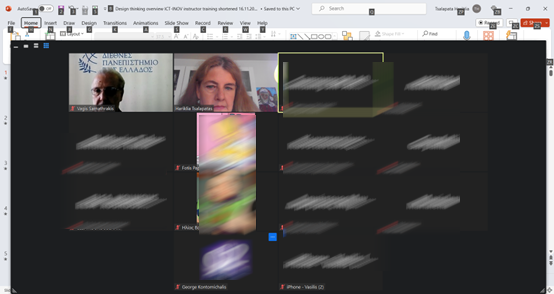
Description of the course
The course offers basic knowledge on the management and organization of businesses and their operations. It focuses on many different areas, including finance, marketing, accounting, human resources, and more. It provides students with the knowledge and skills needed to succeed in a variety of business-related careers.
Description of the participants
The course is mandatory in the 1st year of studies of the Logistics and Informatics Department of the International University of Greece, which is located in Thessaloniki. A design thinking workshop based on the principles introduced by ICT-INOV was delivered in the context of the course in the fall of 2023 after a formal invitation by the International University of Greece. The workshop was attended by approximately 40 students and educators of the International University of Greece.
Description of gamified design thinking activities
Students worked towards introducing solutions to challenges related to the UN Sustainability Goals. They worked in groups of 2 to 3 individuals. An activity was created for the purpose of the workshop in the ICT-INOV digital learning platform. The workshop took place in hybrid mode, with approximately 25 individuals being physically present in the classroom while 16 were present on-line. The lack of availability of computers led to activities taking place off-line, following ICT-INOV principles.
Activities were organized in the following steps.
Step 1. Creativity and team building.
Students were encouraged to draw an object that is of use to someone using predefined shapes. The purpose of the exercise was to boost the confidence of students in their creative nature.
Subsequently, students were asked to decide on a team name and create a team logo as a team building exercise.
Step 2. Discovery.
Students performed discovery exercises on the broad subject of sustainability. They noted ideas related to sustainability. They established associations between the concept of sustainability and places, people, actions, and feelings. Finally, they selected a specific sustainability topic and described it through images, videos, scientific articles, and press articles that they researched on the internet. Students presented their work to the class.
Step 3. Problem re-definition.
Students defined the problem they decided to work on in the form “how might we … design something that … allows users to …”.
Step 4. Ideation.
Students performed ideation exercises in order to generate as many ideas as possible towards solving the problem in focus. Exercises included noting ideas and building on the ideas of other team members.
Step 5. Idea selection.
Students categorized the ideas generated in the ideation phase in 3 groups: simple ideas, innovative but feasible ideas, and ideas for which technology is not yet mature enough to implement. They were asked to select an idea from the innovative but feasible pool and present it to the class.
Step 6. Prototyping.
Students became familiar with prototyping principles for generating user feedback on a proposed solution, including physical prototypes for tangible solutions as well as storyboards and user journey descriptions of intangible solutions.


